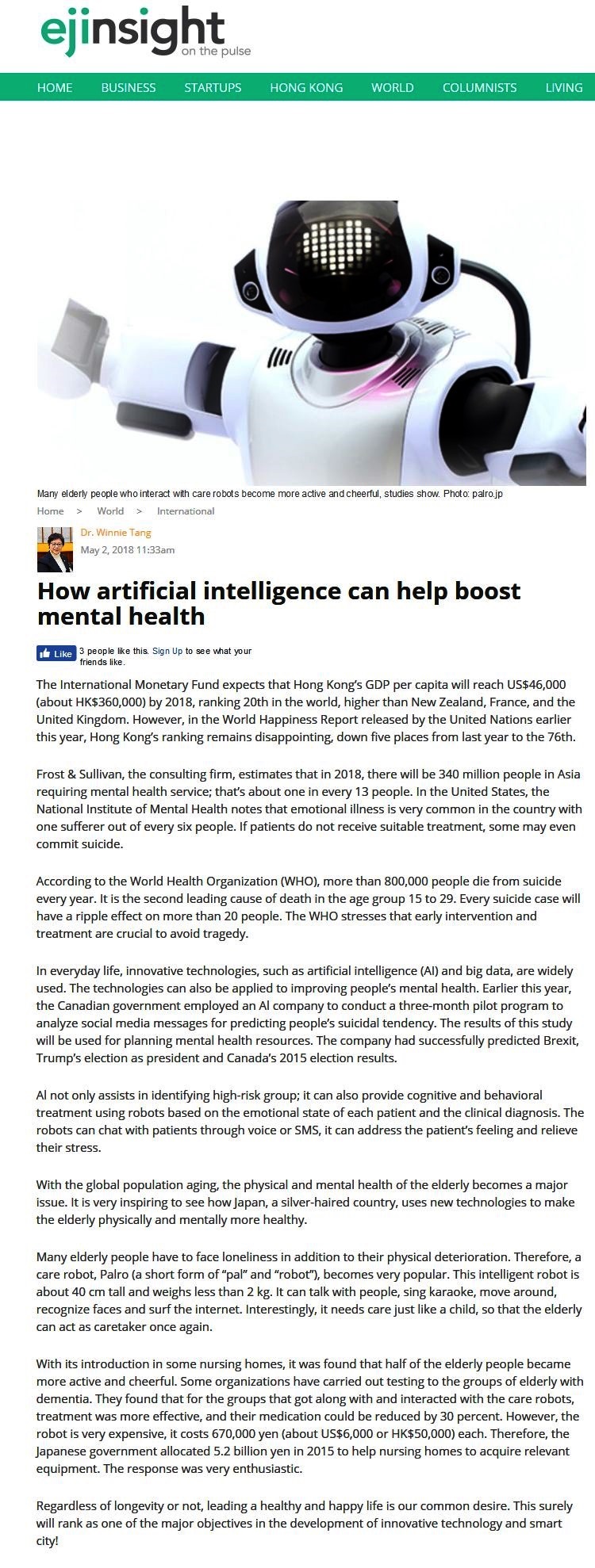網上版請按此

How artificial intelligence can help boost mental health
The International Monetary Fund expects that Hong Kong's GDP per capita will reach US$46,000 (about HK$360,000) by 2018, ranking 20th in the world, higher than New Zealand, France, and the United Kingdom. However, in the World Happiness Report released by the United Nations earlier this year, Hong Kong's ranking remains disappointing, down five places from last year to the 76th.
Frost & Sullivan, the consulting firm, estimates that in 2018, there will be 340 million people in Asia requiring mental health service; that's about one in every 13 people. In the United States, the National Institute of Mental Health notes that emotional illness is very common in the country with one sufferer out of every six people. If patients do not receive suitable treatment, some may even commit suicide.
According to the World Health Organization (WHO), more than 800,000 people die from suicide every year. It is the second leading cause of death in the age group 15 to 29. Every suicide case will have a ripple effect on more than 20 people. The WHO stresses that early intervention and treatment are crucial to avoid tragedy.
In everyday life, innovative technologies, such as artificial intelligence (AI) and big data, are widely used. The technologies can also be applied to improving people's mental health. Earlier this year, the Canadian government employed an Al company to conduct a three-month pilot program to analyze social media messages for predicting people's suicidal tendency. The results of this study will be used for planning mental health resources. The company had successfully predicted Brexit, Trump's election as president and Canada's 2015 election results.
Al not only assists in identifying high-risk group; it can also provide cognitive and behavioral treatment using robots based on the emotional state of each patient and the clinical diagnosis. The robots can chat with patients through voice or SMS, it can address the patient's feeling and relieve their stress.
With the global population aging, the physical and mental health of the elderly becomes a major issue. It is very inspiring to see how Japan, a silver-haired country, uses new technologies to make the elderly physically and mentally more healthy.
Many elderly people have to face loneliness in addition to their physical deterioration. Therefore, a care robot, Palro (a short form of "pal" and "robot"), becomes very popular. This intelligent robot is about 40 cm tall and weighs less than 2 kg. It can talk with people, sing karaoke, move around, recognize faces and surf the internet. Interestingly, it needs care just like a child, so that the elderly can act as caretaker once again.
With its introduction in some nursing homes, it was found that half of the elderly people became more active and cheerful. Some organizations have carried out testing to the groups of elderly with dementia. They found that for the groups that got along with and interacted with the care robots, treatment was more effective, and their medication could be reduced by 30 percent. However, the robot is very expensive, it costs 670,000 yen (about US$6,000 or HK$50,000) each. Therefore, the Japanese government allocated 5.2 billion yen in 2015 to help nursing homes to acquire relevant equipment. The response was very enthusiastic.
Regardless of longevity or not, leading a healthy and happy life is our common desire. This surely will rank as one of the major objectives in the development of innovative technology and smart city!
Dr. Winnie Tang
Honorary Professor, Department of Computer Science, The University of Hong Kong